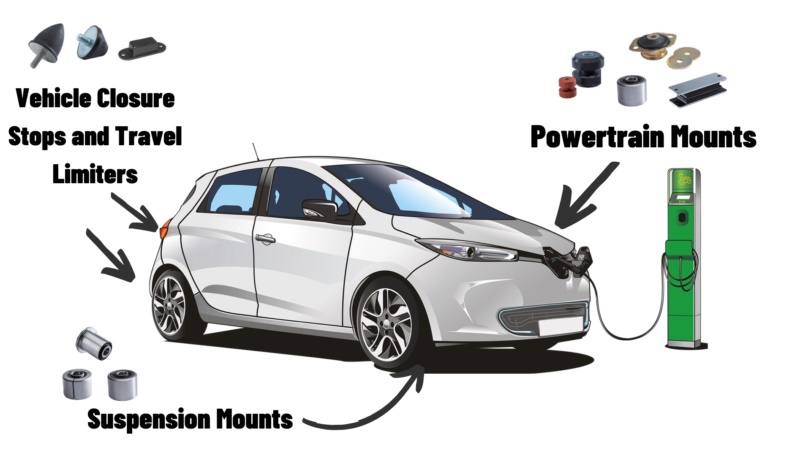The automotive rubber manufacturing industry is undergoing significant transformations due to the rapid rise of electric vehicles (EVs). As the automotive landscape shifts towards electrification, manufacturers are adapting to meet the unique demands of this new technology. This blog explores the key trends, challenges, and innovations in automotive rubber manufacturing as it responds to the growing prominence of electric vehicles.

Key Trends in Automotive Rubber Manufacturing
- Specialized Rubber Components for EVs
Electric vehicles require specialized rubber components tailored to their unique operational needs. For instance, battery packs demand high-performance seals and gaskets to ensure safety and prevent leaks. Additionally, components such as electric motors and inverters necessitate rubber parts that can withstand high temperatures and vibrations. The evolution of these specialized components is crucial for maintaining the efficiency and reliability of EV systems.
Moreover, as EVs incorporate more complex electronic systems, manufacturers are focusing on producing rubber parts that can integrate seamlessly with these technologies. Innovations like smart seals with sensors to monitor wear or potential leaks are becoming increasingly common, enhancing safety and performance.
- Lightweight and Durable Materials
To enhance range and efficiency, electric vehicles focus on reducing weight. Consequently, rubber manufacturers are developing lightweight yet durable rubber compounds that meet these requirements. Advanced technologies such as nanotechnology are being employed to enhance properties like strength, flexibility, and heat resistance. These innovations ensure that rubber components can perform effectively under the demanding conditions present in electric vehicles.
Additionally, the automotive industry is witnessing a shift towards low-rolling resistance tires designed specifically for EVs. These tires utilize specialized rubber compounds with optimized tread patterns to maximize energy efficiency, further contributing to the overall performance of electric vehicles.
- Sustainability and Eco-Friendly Practices
As environmental concerns grow, sustainability has become a central theme in automotive manufacturing. Rubber manufacturers are increasingly exploring eco-friendly alternatives, such as recycled rubber and bio-based materials. This shift not only reduces the environmental impact of production but also aligns with consumer demand for sustainable products.
The emphasis on sustainability extends beyond materials; manufacturers are also adopting greener production processes. This includes implementing circular economy principles by recycling used rubber products and investing in research to develop renewable alternatives that maintain high-performance standards.
Challenges Facing the Automotive Rubber Industry
- Supply Chain Disruptions
Despite advancements in technology and increased global connectivity, the automotive rubber industry faces ongoing supply chain disruptions. Factors such as geopolitical tensions and natural disasters can significantly impact the availability of raw materials. As a result, manufacturers must proactively manage their supply chains to mitigate risks associated with material shortages.
With approximately 90% of rubber produced in Asia, U.S. and European manufacturers may find it increasingly challenging to source necessary materials due to trade embargoes and tariffs. To address these challenges, companies are turning to smart manufacturing technologies that utilize machine learning algorithms for accurate demand forecasting. This allows manufacturers to better predict supply levels and adjust their procurement strategies accordingly.
- Increased Demand for Synthetic Rubber
The growing popularity of electric vehicles has increased the demand for synthetic rubber due to its versatility and performance benefits compared to natural rubber. Synthetic rubber offers greater flexibility in properties such as heat resistance and durability, making it ideal for various automotive applications. However, this increased demand places additional pressure on manufacturers to innovate continuously while ensuring sustainable sourcing practices.
Innovations Shaping the Future
- Advanced Manufacturing Techniques
The adoption of advanced manufacturing techniques is changing the way rubber components are produced. Technologies like 3D printing enable manufacturers to create complex rubber parts with greater precision and efficiency than traditional methods allow. This capability not only speeds up prototype development but also facilitates customization options that meet specific customer needs.
Furthermore, innovations in material science are leading to the development of custom rubber compounds designed specifically for electric vehicle applications. These advancements ensure that manufacturers can provide solutions tailored to the evolving requirements of modern vehicles.
- Focus on Safety and Reliability
As electric vehicles become more prevalent, ensuring the safety and reliability of rubber components is paramount. Manufacturers are investing in rigorous testing and quality control processes to meet stringent safety standards. This commitment not only enhances product quality but also builds consumer trust in EV technology.
Conclusion
The rise of electric vehicles is reshaping the automotive rubber manufacturing landscape, presenting both opportunities and challenges for manufacturers. By focusing on specialized components, lightweight materials, sustainable practices, and advanced manufacturing techniques, the industry is well-positioned to meet the demands of this evolving market.
As automakers continue to embrace electrification, the role of high-quality rubber components will be vital in ensuring vehicle performance and safety. Through innovation and adaptability, automotive rubber manufacturers can play a crucial role in driving the future of transportation while contributing to a more sustainable world.
